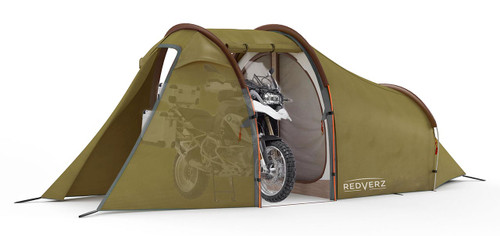We like this style of tent. Adequate sleeping space, and plenty of area in the porch to keep all of our gear inside, dry and out of the way.
Packed, it fits easily inside a pannier - but we normally strap it to the grab rail so that it rests on top of the pannier, but it is the grab rail that takes most of the weight.
The view in the mirror is slightly obscured, so I prefer to put it on the nearside (left in the UK).
This way, the tent is always the last thing to be loaded and the first to be removed - so we can pack everything up in the dry if it is raining outside. The tent can be pitched as one, or flysheet first. This is useful for packing a wet tent - the inner can be put in a bin liner to keep it separate from the wet fly. There are straps linking the bottom of each pole to the other side which ensures that the fly is pitched accurately. The inner suspends from toggles on the fly seams, and is secured at to base to the fly sheets pegging points by quick release buckles.
The tent pitches well and withstands very strong winds, continuous heavy rain and has enough ventilation for condensation not to be a problem. It has front and side doorways, and mosquito nets for the inner and the main side entance.
The only thing I hate about it is the red guylines. Red does not stand out against green grass.
We have a pannier each for our own clothes and stuff. Cooking gear and tomorrow's breakfast all go into a tank bag and the sleeping gear goes in the top box. Insulation mats are carried in a bag strapped to the grab rail on the off side of the bike. This is smaller than the tent bag and doesn't obscure the view in the mirror. We use two down filled 'blankets' rather than sleeping bags. These press-stud together and provide better insulating warmth than sleeping bags, for half the volume.
The tent is a Robens Voyager 2Ex. They are not cheap, but I find that you get what you pay for, and this is pretty good kit. I have been let down by cheaper tents, and we have had a Robens with a similar design (Black Shrimp) for years and it worked well for us. The blurb says that packed it is 43 x 17 cm and weighs 3.2kg - so that is 17 inches long x 6.6 inches diameter and 7lb.
I find that most modern tents have inadequate 'groundsheets' ie, they are not 100% waterproof and overnight it is possible to find that damp seeps through from the ground. This tent seems to have a more substantial base than many that I have seen recently, but we still take a waterproof PVC groundsheet with us. Ignore figures quoting hydrostatic head when jt comes to the groundsheet. That figure means that at some point, water will get through. I don't know what rating is given for the sheet on this tent, but my previous one was 10,000mm and we have woken with the area under our insulating air mats completely wet.
They wouldn't sell footprint groundsheets if the ones that come with the tent was 100% waterproof.
To be honest, I much prefer lightweight canvas tents. The early Vango Force 10 tents were brilliant. They pitch better, they are warmer and the canvas tightens when they get wet, which means that they don't flap about in strong winds - unlike synthetic materials which get slacker and noisier in the rain. But canvas tents are heavier, occupy more volume when packed and are difficult to pack into the same space that they arrived in after a night of rain. but if we go camping in the car, we take the Vango Force 10 with its extension flysheet.
Further information about the Robens tent in the photo is here:
The two-person Voyager 2EX is a stable tunnel tent thanks to features that include the ripstop polyester outer, flat pole sleeves and aluminium alloy poles. It features a large extended porch perfect for expedition pack storage or for foul weather relaxation - something that is much appreciated...

www.robens.de
We didn't pay anything like that quoted price for ours. It was about half of that IIRC. I could suggest ways that would make this design better, but so far this has done us proud, and it comes pretty close to what we need, without any of the annoying little traits that ere usually present in cheaper tents.
Apart from those red guys. I know that there is a 'colour blindness' to do with being unable to distinguish between red and green. It is hard to imagine how this can affect the people that have it. It all became very clear to me, as I picked myself up from the wet grass for the third time on one morning. Those guy lines just disappear into the grass.











